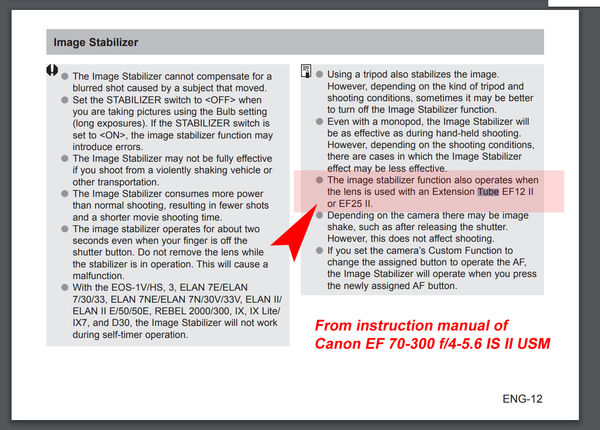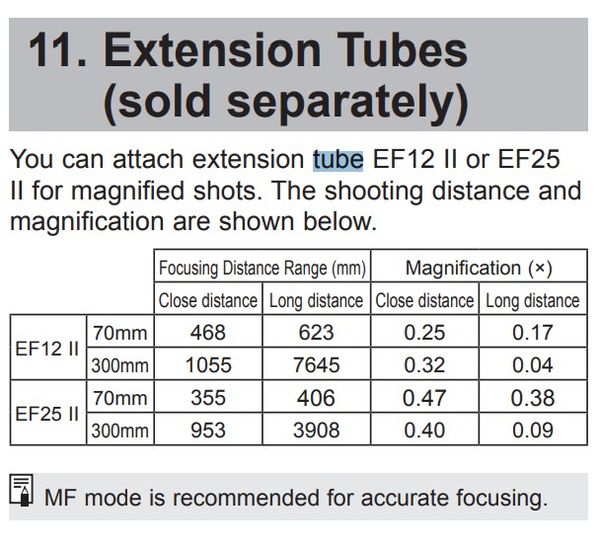Extension Tubes
Jan 30, 2019 12:37:29 #
I have had extension tubes (12, 20, 35mm) for a number of years, but not used them. I have lenses: 50, 24-70, 70-300. I am interested in those who use extension tubes, what mm used and with what lenses.
Jan 30, 2019 12:40:33 #
Each tube (or combination) will have a different effect on each lens.
I would recommend you try them to see how they work.
Each combination would have its own application. Depends on the subject.
I would recommend you try them to see how they work.
Each combination would have its own application. Depends on the subject.
Jan 30, 2019 12:41:08 #
Try the 12 with the 50 and the 20 with the 70-300. The difficulty with the shorter lenses is how close you have to be to the subject to be able to focus w/ the tube. Set the 70-300 to 300 and attach the extension tube and see how close to the subject you can now focus.
Jan 30, 2019 13:09:57 #
hlpeterson wrote:
I have had extension tubes (12, 20, 35mm) for a number of years, but not used them. I have lenses: 50, 24-70, 70-300. I am interested in those who use extension tubes, what mm used and with what lenses.
I have four sets of them (three in each set). All slightly different types as well for my various Pentax cameras and lenses. For macro you'd probably get the sharpest image with a 50mm prime lens and tube(s). Also note slow Zoom lenses will be dark to focus thru. I use different lenses and combinations of tubes to get different magnifications. You can look up the appropriate lens formula to calculate the magnification and working distance you will get for each set up if you care to know. Best, just try them out and play with them.
Jan 30, 2019 13:43:39 #
like lamiaceae said... a normal prime...
Did you read/study the instructions that accompanied your extension tubes?
If you did you would know that they clearly state NOT to use them on anything other than a light normal focal length lens... I don't know any extension tube set that is designed to support the weight of your 24-70 or 70-300... besides your instruction will also likely indicate to use them with primes only...
Yes I use them and sometimes with a lens reversing ring...
bty your instruction will likely specify to attach the tube(s) to the body first, then mount the lens...
While I use "Auto" extension tubes on my Nikon FX & DX bodies older tube will work if you can stop down the lens manually... but focus is a challenge so nail it before you stop down, k?
Hope this helps or is at least food for thought...
btw, would also advise to read vendors instructions carefully and follow religiously...
A.K.A. don't take my post literally... it is only appropriate and germane for my kit...
Your kit may be different...
Thanks and enjoy your journey...
Extension Tubes are likely the most cost effective and amazing accessory available...
Did you read/study the instructions that accompanied your extension tubes?
If you did you would know that they clearly state NOT to use them on anything other than a light normal focal length lens... I don't know any extension tube set that is designed to support the weight of your 24-70 or 70-300... besides your instruction will also likely indicate to use them with primes only...
Yes I use them and sometimes with a lens reversing ring...
bty your instruction will likely specify to attach the tube(s) to the body first, then mount the lens...
While I use "Auto" extension tubes on my Nikon FX & DX bodies older tube will work if you can stop down the lens manually... but focus is a challenge so nail it before you stop down, k?
Hope this helps or is at least food for thought...
btw, would also advise to read vendors instructions carefully and follow religiously...
A.K.A. don't take my post literally... it is only appropriate and germane for my kit...
Your kit may be different...
Thanks and enjoy your journey...
Extension Tubes are likely the most cost effective and amazing accessory available...
Jan 30, 2019 13:57:04 #
Thomas902 wrote:
... I don't know any extension tube set that is designed to support the weight of your 24-70 or 70-300... besides your instruction will also likely indicate to use them with primes only...
... I don't know any extension tube set that is designed to support the weight of your 24-70 or 70-300... besides your instruction will also likely indicate to use them with primes only...
The items below common to the instruction manuals of many Canon lenses might help in your working knowledge and application of extension tubes ... page 20 of the same manual goes on to provide a chart of the focus distance changes and level of magnification when either of the two Canon tubes are used with this lens, another common entry in the manuals for many Canon lenses.


Jan 30, 2019 14:54:26 #
CHG_CANON those Canon tubes are a high end product and rather pricey... the 25mm alone cost more than the Kenko three ring auto set... and yes they have an excellent build quality thus can likely handle the weight of longer optics... no argument there...
That said, the moment you move away from a normal lens (i.e. 50mm) there are two serious issues...
Wide angle optics will require being almost next to the object of interest... like an inch away (impossible to light effectively) While long focal lengths suffer from major diffraction degradation... meaning become unacceptably soft at anything over f/5.6 (image stacking is the workaround).
Guess what I'm saying is practical experience will quickly show that a "normal" focal length allows for a reasonable working distance and the ability to stop down to f/8 or f/11 without image degradation...
That said there are now excellent cheap (made in china) manual focus macro lens that have virtually remove the cost savings of tubes from the table... enough said...
btw, thank you CHG_CANON for providing Canon's documentation for their 70-300mm... it is appreciated.
This is also the reason I qualified my post with a caveat "A.K.A. don't take my post literally... it is only appropriate and germane for my kit... Your kit may be different... " meaning my post is only authoritative for my set of "cost effective" tubes i.e. cheap knock-offs
In fact I have crazy colleagues who purchase old 2X manual Nikkor tel-extenders; remove the optics and use for tubes... haven't gotten that desperate (yet)... lol
That said, the moment you move away from a normal lens (i.e. 50mm) there are two serious issues...
Wide angle optics will require being almost next to the object of interest... like an inch away (impossible to light effectively) While long focal lengths suffer from major diffraction degradation... meaning become unacceptably soft at anything over f/5.6 (image stacking is the workaround).
Guess what I'm saying is practical experience will quickly show that a "normal" focal length allows for a reasonable working distance and the ability to stop down to f/8 or f/11 without image degradation...
That said there are now excellent cheap (made in china) manual focus macro lens that have virtually remove the cost savings of tubes from the table... enough said...
btw, thank you CHG_CANON for providing Canon's documentation for their 70-300mm... it is appreciated.
This is also the reason I qualified my post with a caveat "A.K.A. don't take my post literally... it is only appropriate and germane for my kit... Your kit may be different... " meaning my post is only authoritative for my set of "cost effective" tubes i.e. cheap knock-offs
In fact I have crazy colleagues who purchase old 2X manual Nikkor tel-extenders; remove the optics and use for tubes... haven't gotten that desperate (yet)... lol
Jan 30, 2019 19:38:15 #
Jan 30, 2019 22:00:58 #
hlpeterson wrote:
I have had extension tubes (12, 20, 35mm) for
a number of years, but not used them. I have
lenses: 50, 24-70, 70-300. I am interested in
those who use extension tubes, what mm used
and with what lenses.
I have had extension tubes (12, 20, 35mm) for
a number of years, but not used them. I have
lenses: 50, 24-70, 70-300. I am interested in
those who use extension tubes, what mm used
and with what lenses.
Since I have purpose built macro lenses from
35 to 200mm, I have no reason to use tubes
with any other lenses.
You ask what length tubes with what lenses.
With real macro lenses, there's no reason to
use a tube that is less than half the FL of that
lens cuz that would be redundant to the focus
range already built into the lens.
That is what I do. To explain WHY would fill a
page and involve a lotta math. Therefor just
google "macro-extension-magnification".
.
Jan 31, 2019 00:11:45 #
Jan 31, 2019 00:12:42 #
Their are calculators on the web where you can see the magnification and working distance when using any combination.
As for using them on non primes go ahead and give it a go but beware how you support the rig to alleviate putting too much load on the tube flanges (if the cheaper type eg Kenko).
I used my 36mm tube with a Nikon D800 and heavy 70-200mm f/2.8 recently and achieved superb results.
As for using them on non primes go ahead and give it a go but beware how you support the rig to alleviate putting too much load on the tube flanges (if the cheaper type eg Kenko).
I used my 36mm tube with a Nikon D800 and heavy 70-200mm f/2.8 recently and achieved superb results.
Jan 31, 2019 06:33:45 #
billnikon
Loc: Pennsylvania/Ohio/Florida/Maui/Oregon/Vermont
hlpeterson wrote:
I have had extension tubes (12, 20, 35mm) for a number of years, but not used them. I have lenses: 50, 24-70, 70-300. I am interested in those who use extension tubes, what mm used and with what lenses.
The major disadvantage of extension tubes is that they usually result in a very narrow depth of field, the larger the tube, the worse the depth of field. You must stop down to 16, to 22 to get decent depth of field and you also need lots of light, even then you must really be careful because of the limited range of depth of focus. They are fun to use though.
Jan 31, 2019 07:50:09 #
mas24
Loc: Southern CA
Thomas902 wrote:
CHG_CANON those Canon tubes are a high end produc... (show quote)
I had a friend who owned the Kenko Extension Tubes, that he used for Macro on prime lenses only. Later, he decided to purchase a Tamron 90mm f2.8 Macro lens with a 1:1 magnification.
Jan 31, 2019 09:16:32 #
I like extension tube. They're a cheap, basic way to do macro.
One tip: most extension tubes have a silver button for removal. You must SLIDE that button, in most cases, in order to remove the tube. People press the button and can't understand why the tube won't come off.
One tip: most extension tubes have a silver button for removal. You must SLIDE that button, in most cases, in order to remove the tube. People press the button and can't understand why the tube won't come off.
Jan 31, 2019 09:22:33 #
wingclui44
Loc: CT USA
hlpeterson wrote:
I have had extension tubes (12, 20, 35mm) for a number of years, but not used them. I have lenses: 50, 24-70, 70-300. I am interested in those who use extension tubes, what mm used and with what lenses.
Why don't you try yourself with every combination, and see the reason yourself, have fun!
If you want to reply, then register here. Registration is free and your account is created instantly, so you can post right away.



